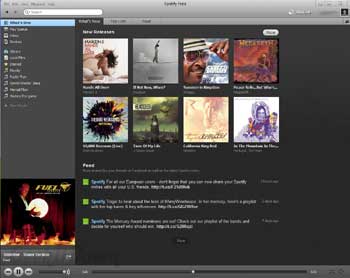Spotify is the newest invasion from Europe and with it comes the promise of unlimited streaming music for free. Spotify is currently in an invite only release state and there’s no specific indication on when it will emerge from invite only. You can claim an invite at Spotify.com.

We’re going to look at the Spotify interface as well as streaming and accessibility of the songs. We’ve decided not to focus on overall song selection and variety since that is mostly specific to the user but needless to say, Spotify has an enormous selection of music to choose from with literally millions of songs.
Playback
Spotify playback is smooth. We had nearly zero hiccups, pauses, skips or stream interruptions. The songs are clear and titles match what is being played. We taxed our system somewhat during playback in order to test streaming as resources became limited. Spotify showed no ill effects. Bouncing from song to song was quick and we experienced no buffering delays.
Interface
Spotify, like iTunes and others, use their own interface which is installed on your computer system. It feels and looks similar to iTunes and has a drag and drop style interface. It’s fairly simple and has all the basics such as playlists, queu, inbox, local files, etc. We thought their search function was more than adequate giving variations on whatever you search for with complete catalogs for artists.

The interface tucks away as a tray icon which keeps your taskbar a bit leaner. As far as preferences go, you can add Facebook contacts to share music interests and directly feed Last.fm settings into the player. If you want to tell your social friends about a song, sharing through Twitter and Facebook is a click away. You can also get links for individual tracks to email others. Local files can, of course, be played and viewed through the Spotify interface.

For those looking for a mobile interface, Spotify has an app available but it requires a premium subscription of $9.99/month to gain access to the Spotify music library.
Ads
The intermittent audio ads run roughly 20 seconds in length and are a small price to pay for free streaming music. The visual ad displays are the length of the interface window and shrink the search results area when displayed. The most annoying part of the audio ads, for whatever reason, is that they are for music genres completely opposite of the music taste portrayed in playlists, queu and past searches. Muting the ad was our first reaction, however if the volume is turned down less than two-thirds to three-quarters volume the ad will pause until you turn the volume back up. A sneaky way to promise your advertisers that users will hear the ads, but at the same time sort of smart on their part.
Competition
Compared to Pandora, Spotify actually allows users to select the song they want to listen to, when they want to hear it. That alone is enough to make the switch from Pandora to Spotify. Spotify could seemingly replace iTunes since, with Spotify, everything is in the cloud and a simple search or click away while iTunes requires storage space and per song payment with download.
Final Thoughts
Spotify itself seems to be a nice alternative to services like Pandora and Slackr. Is it a replacement for them? Yes, but it’s just not there yet. Mainly due to mobile cost for their premium service, remember Pandora is free. Compared to iTunes, Spotify could eventually replace them if Spotify can pick up steam and word-of-mouth. With Spotify Premium for offline playback there isn’t much of an advantage to iTunes. Spotify is the real deal when it comes to free streaming music. For this review we tested Spotify on Windows and Linux. There was only one major difference found while testing on both systems and so we separated that one issue into a Linux note below.
Linux Notes:
Spotify has yet to release a Linux version of their software but suggests installation of the Windows version through wine. We tried that and these are the results. The most glaring and problematic issue with the Spotify interface via wine is when it fails to play a song. Our testing indicates the Spotify interface fails playback when the system is taxed or an ad is inadvertently skipped. The issue unfortunately doesn’t stop with a simple song failure. The interface essentially stops playing any songs at all. The interface itself is usable, the ports remain open and the streams display as ‘in playmode’, however the song timer does not progress and no playback sound is sent to the local machine. It would seem no amount of creative tricks will repair the issue either. Clearing the Spotify cache, logout/login and restart of the application do not fix the issue. In fact the only resolution we were able to come up with is a system reboot which is extremely inconvenient. That playback issue happens every time we use Spotify and after a week of testing has gotten a bit frustrating. If you simply select a song and let it play, without interruption, according to what Spotify has listed next, then you likely won’t experience those problems. But, for most of us, we want to play what we like and that doesn’t always equal a complete album or grouping of songs from search results. While buggy when used through wine, we expect Spotify to finalize a Linux release and as a result eliminate those issues.
Your Thoughts
Have you tried Spotify yet? Do you think Spotify will take off in the US like it has in Europe? Let us know in the comments!

